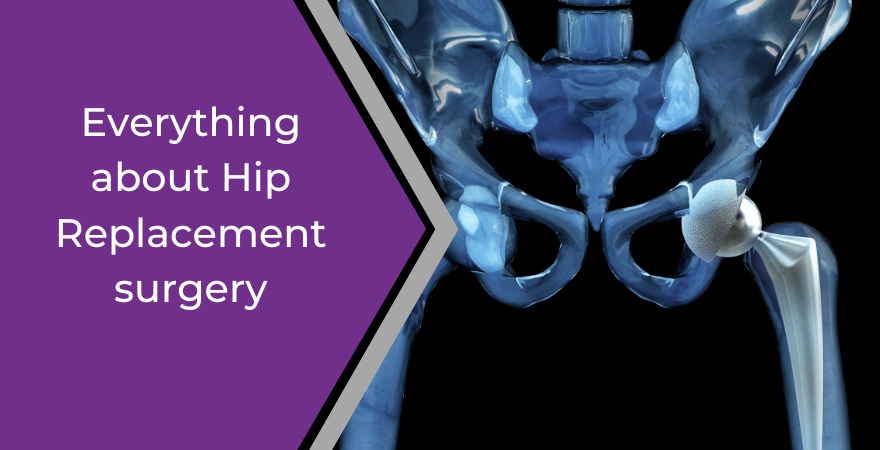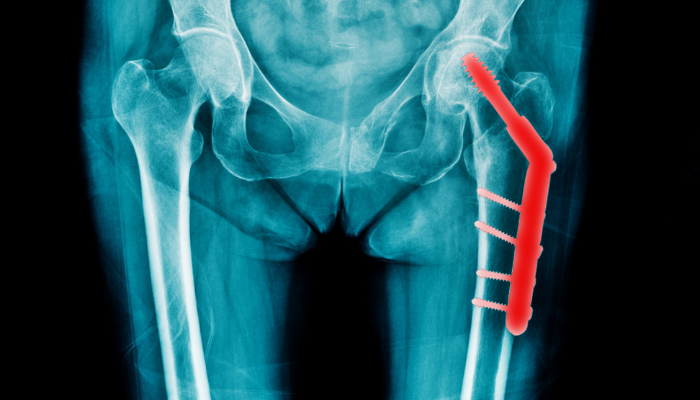
Your hips support the majority of your body weight and is the largest joint in your body. They assist you in moving and walking. So, if they hurt, your day-to-day life can be negatively impacted.
When the hip joints wear out, you eventually start experiencing pain even while you’re at rest. If things worsen, you may also encounter stiffness and muscle weakness and may require an aid while you walk. All of these symptoms indicate the necessity of a hip replacement surgery.
A hip replacement surgery involves replacing the worn-out or damaged portion of the hip joint with a prosthesis (artificial hip joint) made up of plastic, ceramic, metal, or a combination of materials.
In other words, removing and replacing parts or the whole of the pelvis and femur (thighbone) that make up your hip joint. It is generally used to treat hip stiffness and discomfort brought on by hip arthritis.
Although fractures and congenital disorders can also contribute to hip wear, osteoarthritis and rheumatoid arthritis are the most common causes. Both harm the joint cartilage that covers the bones and protects them from injury.
This surgery is occasionally performed to address various illnesses as well as injuries like a fractured or incorrectly developing hip. Although fractures and congenital disorders can also contribute to hip wear, osteoarthritis and rheumatoid arthritis are the main causes. Also called as Hip Arthroplasty, this hip surgery was first introduced in the year 1960 and is known to have high success rates worldwide.
Hip replacement surgery can help you get back to your daily routine and doing the things you love.
Benefits Include:

| Hip Replacement FactAccording to the Agency for Healthcare Research and Quality, more than 1.5 million total hip replacements are performed each year worldwide. |
Mainly there are two types of hip Replacement Surgery– Partial Hip replacement and total Hip replacement.
A total hip replacement involves replacing the ball (femoral head) and socket of your hip joint with synthetic components made of metal, polyethylene, or ceramic. In most cases, patients with advanced arthritis or a condition affecting the ball and socket of the hip should consider a total hip replacement.
| Did you know?With modern implant and surgical techniques, over 90% of total hip replacements survive more than 20 years. |
Some candidates for hip replacement may be eligible for a partial hip replacement. Here, only the ball of the hip joint may be replaced partially.
A partial replacement can be your best option if you have a hip fracture in the elderley. Are you the right candidate for a Hip Replacement procedure?
Our hip surgeon takes into account a variety of factors, including the severity of your symptoms, your general health, and your reaction to previous therapy, to decide the best hip replacement operation for you.
Surgery may be suggested if you are exhibiting any of the following symptoms:
Dr. Sabri’s posterior approach surgery does not cut any of the major muscles around the hip. Instead, he separates them in a unique fashion that allows access to various parts and promotes quicker healing. This method is regarded as muscle sparing approach which also enhances a quicker recovery and earlier return to a normal walking pattern.
The patient accordingly is benefited by:
Sometimes hip replacements can be performed as a day-case procedure in some facilities, which eliminates the need for an overnight stay. Our surgeon will take into account your age, general health, mobility, degree of exercise, and support system at home to determine if you require an inpatient stay or not.
Physical rehabilitation starts a few hours after surgery, thanks to developments in pain management. The majority of patients go back home in one to three days. Following surgery, the typical time frame for taking painkillers is one to four weeks.
You may experience a 2 to 4-week absence from work following hip replacement surgery. Patients generally have mild pain which is typically controlled via simple analgesia. Opioids are usually avoided but can be used infrequently.
Going ahead, patients must begin moving their new joint and develop an exercise regimen with the help of a physiotherapist. This will increase strength and free flow of motion.
Individual recovery timeline depends on the patient’s age and general condition at the time of operation. However, most patients tend to return to normal walking without any aids around 6 weeks.
Dr Omar Sabri specialises in surgeries for fragility fractures, major trauma, and pelvis and hip reconstruction.
He is one of the few Mako-trained (Robotic-Arm Assisted Makoplasty) surgeons who holds expertise in the reconstruction of the lower limb in cases of bone and joint infection. He is your contemporary, tech-savvy surgeon with a focus on robotic surgery, virtual reality training, and healthcare innovation.
Make an appointment today to discuss your hip issue with one of the top hip surgeons in Dubai.